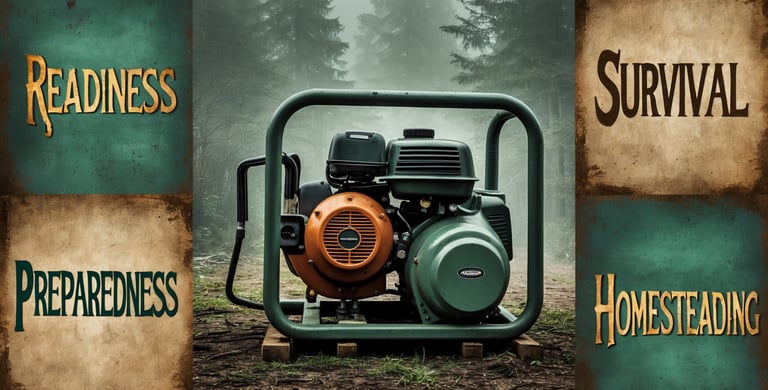Survival: Survival Fitness
Strength, Endurance, and Mobility Under Load and Duress
4FORTITUDER - READINESS, SURVIVAL, PREPAREDNESS, HOMESTEADING
Survival: Survival Fitness
Strength, Endurance, and Mobility Under Load and Duress
“You don’t rise to the occasion—you fall to the level of your training.”
— U.S. Navy SEAL Maxim
Survival Isn’t an Event—It’s a Physical Burden
When the moment comes, you won’t get to warm up. You’ll lift someone twice your weight. You’ll drag a load over uneven ground. You’ll run while hungry, climb while afraid, fight while tired. Survival fitness is not about looking fit—it’s about staying alive when comfort dies.
You must train not for perfection—but for durability under disaster.
Eastern wisdom reminds us: “Flow like water, but stand like a mountain.” Survival fitness fuses strength, mobility, and endurance into one practiced capability. This is not gym-based training. It is combat physiology—real-world preparation for real-world demands.
Core Knowledge Foundation: The Triad of Survival Fitness
Every physical survival scenario tests three integrated traits:
Functional Strength – Can you carry, lift, drag, climb, or break?
Sustainable Endurance – Can you move for hours without collapsing?
Joint-Controlled Mobility – Can you squat, crawl, vault, twist, or descend without injury?
Misconception Warning: Muscle mass alone is not survival fitness. If you can deadlift 500 lbs but can’t hike 5 miles with 30 lbs on your back—you’re a statue, not a survivor.
1. Functional Strength – Not Max, But Capacity
Objective: Train your body to move load safely, efficiently, and repeatedly.
How to Train:
Sandbag Carries: 60–100 lb carry for 100 yards, rest 60 sec, repeat x3
Deadlift Variations: Focus on trap bar or suitcase style for carryover
Drag Work: Sled, tire, or makeshift (tarp + load). Pull forward + backward for grip and posterior chain
Why It Works: These build your anti-fragile frame. You don’t need max lifts. You need repeatable strength under irregular, awkward conditions.
Drill: Pack a 40 lb backpack. Carry a 60 lb sandbag. Move 1 mile alternating carry and rest every 3 minutes. Log total time and grip breakdown.
2. Endurance – Built Through Suffering, Not Speed
Objective: Move long distances with control and minimal wear.
How to Train:
Rucking: Walk 3–6 miles with 30–50 lbs. Maintain heart rate below 140 bpm.
Zone 2 Conditioning: Rowing, cycling, or long runs at 60–70% effort for 45–90 minutes.
Threshold Testing: Once/week push session—sprint intervals, hill climbs, stair repeats.
Why It Works: Endurance isn’t about performance—it’s about energy conservation, breath control, and cardiovascular efficiency when your life depends on continuous movement.
Drill: Ruck 5 miles with 35 lbs. Time it. Every 15 minutes, stop and perform 20 pushups. Note how your form and breathing change across time.
3. Mobility – Your Injury Insurance
Objective: Build joints and tissues that move freely and resist breakdown under pressure.
How to Train:
Loaded Carries in Movement Patterns: Lunge + twist, single-leg RDL + reach
Crawling and Climbing: Bear crawls, crab walks, tree limb pull-ups
Controlled Articular Rotations (CARs): Daily 10-min joint control routine (shoulders, hips, spine, ankles)
Why It Works: Most injuries in survival aren’t catastrophic—they’re cumulative: sprains, strains, fatigue tears. Mobility protects you while allowing natural adaptation to odd positions and terrain.
Drill: Perform 5 minutes of quadruped movement across mixed terrain (grass, rock, incline). Focus on knee, wrist, and spine integrity. Repeat weekly.
Advanced Insights: Training Under Duress
Training without discomfort is rehearsal. Survival happens in discomfort.
You must replicate:
Sleep-deprived movement
Fasted output
Decision-making after maximal effort
Historical Anchor: The GORUCK Selection Course
Elite-level ruck-based fitness challenge modeled on Special Forces training. Candidates fail not because they are weak—but because they break under compounded duress: movement + load + fear + fatigue.
You must train in:
Unknown durations (walk until told to stop)
Varied terrain
Disrupted breathing (nasal breathing + talking drills)
Drill: 3-hour fasted ruck. No music. No GPS. Journal after on thoughts, fatigue, foot pain, hydration levels.
Critical Perspectives: Modern Fitness Lies and the False Image of Strength
Adversarial Viewpoint:
“Fitness is about health, not punishment. Overtraining damages the body. Why train for disaster that may never happen?”
Response:
Overtraining is the result of ego, not mission. Survival fitness is not about aesthetics or burnout—it’s about adaptive stress, controlled suffering, and field performance. You train not for punishment, but for peace under pressure.
Wisdom and Warning Duality
When Followed: You move through disaster with capability. You are not winded. You are not injured. You lead because your body obeys.
When Ignored: Your body collapses. You slow others down. You bleed strength through each step—until someone has to carry you.
Strategic Crossroad: Will you be a source of strength—or a weight to be carried?
Final Charge & Implementation
Brother, survival is physical. Every virtue you carry—discipline, calm, vision—must pass through your flesh. If your body fails, your mission dies with it. Train not to impress. Train to endure.
Start Now:
Create Your Weekly Survival Fitness Cycle
“Training must reflect reality—not fantasy.” — 4FORTITUDE Conditioning Creed
Monday: Strength (Sandbags + Deadlifts)
Tuesday: Zone 2 Endurance (60 min ruck)
Wednesday: Mobility (Flow + Crawl)
Thursday: Functional Carry + Drag
Friday: Sprint/Threshold Work
Saturday: Long Ruck + Drill
Sunday: Rest + Reflection
Establish Baseline Metrics Quarterly
“What you don’t track, you’ll forget when pain hits.”
3-mile ruck time with 40 lbs
Max sandbag carry (distance in 5 min)
2-min pushups
60-sec wall sit
5-min crawl flow
Joint pain report and recovery log
Strategic Reflection:
Are you training for aesthetics—or to lift your child and sprint 100 yards when it counts?
Existential Challenge:
If your life depended on it, could you carry someone to safety—uphill, under stress, with no food in your gut?
Prepare your body like a tool forged in fire. Harden the joints. Stretch the lungs. Own your load.
“In survival, your body is the last weapon—and the first to fail if you neglect it.”


